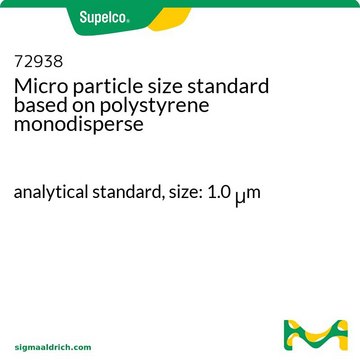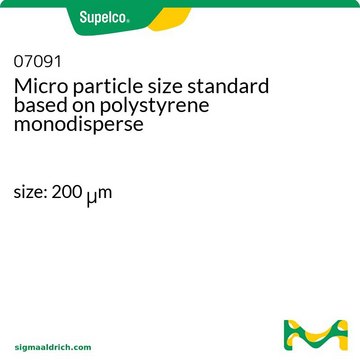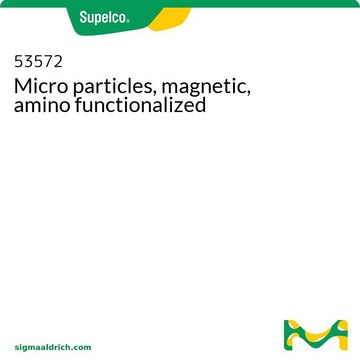59769
Micro particles based on polystyrene
size: 500 nm
Sinonimo/i:
Latex beads from PS
Autenticatiper visualizzare i prezzi riservati alla tua organizzazione & contrattuali
About This Item
Prodotti consigliati
Livello qualitativo
Forma fisica
aqueous suspension
Concentrazione
10% (solids)
Dimensione particelle
500 nm
Densità
1.05 g/cm3
Temperatura di conservazione
2-8°C
Cerchi prodotti simili? Visita Guida al confronto tra prodotti
Categorie correlate
Descrizione generale
Micro Particles or Latex Beads, commonly known as polystyrene microparticles, are negatively charged colloidal particles. The microparticles are produced through a polymerization reaction of styrene under controlled conditions. The conducive environment of the reaction induces spontaneous coalescent bead formation. Micro Particles or Latex beads are supplied in aqueous solutions composed of polymer particles with water. Polystyrene′s refractive index at 589 nm is 1.5905 and 1.602 at 486 nm.
Applicazioni
Micro Particles or Latex Beads is used for a wide variety of applications like:
- Electron Microscopy.
- Cell Counter Calibration.
- Immunodiagnostics, especially for latex agglutination tests, and
- Phagocytosis Research.
Risultati analitici
For every lot exact values of particle size and standard deviation are determined with an accuracy of 0.01 μm using a Coulter Multisizer.
Codice della classe di stoccaggio
10 - Combustible liquids
Classe di pericolosità dell'acqua (WGK)
WGK 3
Punto d’infiammabilità (°F)
Not applicable
Punto d’infiammabilità (°C)
Not applicable
Dispositivi di protezione individuale
Eyeshields, Gloves
Certificati d'analisi (COA)
Cerca il Certificati d'analisi (COA) digitando il numero di lotto/batch corrispondente. I numeri di lotto o di batch sono stampati sull'etichetta dei prodotti dopo la parola ‘Lotto’ o ‘Batch’.
Possiedi già questo prodotto?
I documenti relativi ai prodotti acquistati recentemente sono disponibili nell’Archivio dei documenti.
I clienti hanno visto anche
Shunmugaperumal Tamilvanan et al.
PDA journal of pharmaceutical science and technology, 62(3), 177-190 (2008-07-30)
The objective of this study is to select a multiple-unit sustained-release formulation and to compare it with both commercial immediate and single unit sustained-release capsules and also to determine whether an in vitro-in vivo correlation exists for single- and multiple-
Elizabeth M Walker et al.
Journal of colloid and interface science, 363(1), 307-313 (2011-08-16)
We have studied polydimethylsiloxane (PDMS)-in-1-butyl-3-methylimidazolium hexafluorophosphate ([BMIM][PF(6)]) Pickering emulsions stabilized by polystyrene microparticles with different surface chemistry. Surprisingly, in contrast to the consensus originating from oil/water Pickering emulsions in which the solid particles equilibrate at the oil-water droplet interfaces and
Fiona A Sharp et al.
Proceedings of the National Academy of Sciences of the United States of America, 106(3), 870-875 (2009-01-14)
Many currently used and candidate vaccine adjuvants are particulate in nature, but their mechanism of action is not well understood. Here, we show that particulate adjuvants, including biodegradable poly(lactide-co-glycolide) (PLG) and polystyrene microparticles, dramatically enhance secretion of interleukin-1beta (IL-1beta) by
Sensitive Mie scattering immunoagglutination assay of porcine reproductive and respiratory syndrome virus (PRRSV) from lung tissue samples in a microfluidic chip.
Song JY, Lee CH, Choi EJ, Kim K, et al.
J. Virol. Methods, 178, 31-38 (2011)
Il team dei nostri ricercatori vanta grande esperienza in tutte le aree della ricerca quali Life Science, scienza dei materiali, sintesi chimica, cromatografia, discipline analitiche, ecc..
Contatta l'Assistenza Tecnica.










